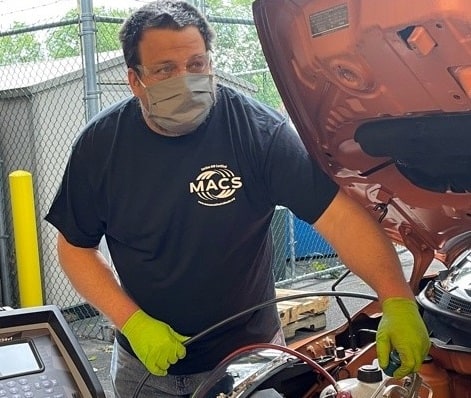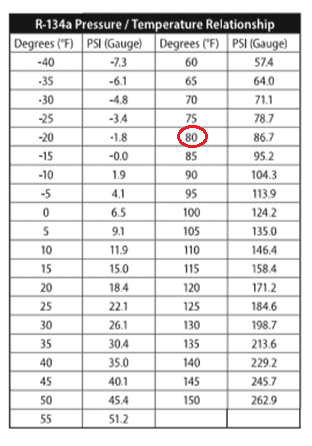Refrigerant capacity and mobile A/C service
By Richard Hawkins, MACS contributor
One of the most frequently asked questions on tech help-line calls concerns refrigerant capacity: How much refrigerant is in that mobile A/C system, and have you checked to be sure the refrigerant is pure?
The answers can sometimes be interesting and can lead in multiple directions.
We shall examine the most common answers and discuss them. Note: If possible, I always look the refrigerant capacity* information up and have it handy if available from the OEM manufacturer before speaking with the customer.
*MACS members have access to refrigerant charge amounts through the MACS APP. If you’re not a MACS member yet you can join us when you click here.
Here’s our first scenario:
Technician A: “It has .9 lbs (which is 14.4 ounces). That’s what the A/C decal on the car calls for and I just charged it up with my R/R /R machine which is only 6 months old. Also, I checked the tank on the machine with my refrigerant identifier and it is 100% pure.”
That is about the best possible answer. The technician obviously researched it and unless there has been a TSB issued which alters it, (and I check for that when looking up the capacity information), it is the correct amount. Also, he checked the purity of the refrigerant, and it isn’t contaminated, so refrigerant contamination can be ruled out.
But there is always the possibility of someone keying the charge amount into the machine incorrectly or even a relatively new machine being out of calibration, but most likely it has the correct charge in it. If it does seems that it has an incorrect charge based on the way the system is behaving, then of course the best course of action is recovering the refrigerant and double checking the procedure and then charge it again. If that doesn’t change anything, then the next thing to do is to use another machine and see if that makes a difference.

Charge amounts being keyed in incorrectly is not all that uncommon. A relatively new machine being out of calibration is rare, but it does happen and is something that can’t be dismissed.
Here’s another scenario:
Technician B: It has a full charge in it.
Me: So, you charged it with .9 lbs. of refrigerant (which is 14.4 ounces)?
Technician B: No, I haven’t charged it. It just came in and is acting weird, so I wanted to get some help from the tech line before spending too much time on it.
Me: But you indicated it had a full charge. What are you basing that answer on?
Technician B: It had the right pressure.
Me: Can you explain a bit more about it having the “right pressure”.
Technician B: Sure. I have one of those charts on my A/C machine that shows what the system pressure is supposed to be at different temperatures. It is 80 degrees outside today and this chart says the pressure of R-134a is supposed to be 86.7 PSI at 80 degrees. The car sat here all night and I checked the system pressure before I started it up and it read about 87 to 88 PSI, so it is right where it is supposed to be.
Me: That is a temperature/pressure relationship chart you have there. What it tells you is what the pressure will be at a given temperature when the refrigerant is in a saturated condition. Saturated condition means when there is liquid and vapor refrigerant present. Stated a little differently, it means that unless the refrigerant is contaminated, the pressure will be what that chart indicates if there is at least one drop of liquid in the system (or container) the refrigerant is in. An example would be taking a full 30 lb. cylinder of R-134a and checking the pressure at a given temperature. You could use that cylinder to charge multiple vehicles and check the pressure after each charge and it will be what that chart indicates until there is no liquid left in the tank.
At that point depending on how much vapor is in the tank, the pressure will then deviate from the chart. So, the pressure that system had (also known as static pressure) before you started it up doesn’t tell us anything about the amount of refrigerant in the system.

A Pressure/Temperature Relationship chart indicates what the refrigerant pressure will be at a given temperature but indicates nothing about the amount of refrigerant in a system or container.
Technician B: Gee I didn’t realize that. Thinking about reading the pressure on refrigerant tanks, I see what you mean.
Check back in next week and we will explore the answer from Technician C.
MACS members have access not only to our mobile diagnostics APP with refrigerant capacities and more but a whole range of benefits. Join MACS today!

Leave a Reply